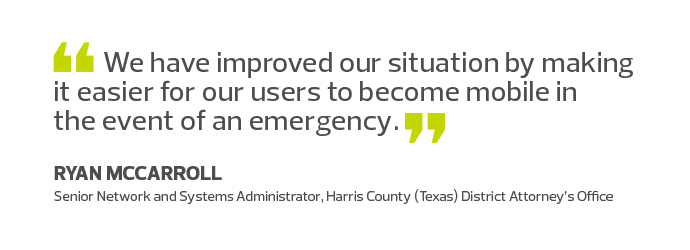State and Local Agencies See Power in the VDI, HCI Combination
Last summer, when torrential rains from Hurricane Harvey flooded the criminal courthouse in downtown Houston and displaced employees, the IT team at the Harris County District Attorney’s Office saw firsthand the importance of providing users remote access to applications.
With the Harris County Criminal Justice Center closed and needing extensive repairs, the DA’s office spent several months relocating its main data center and most of its 750 prosecutors, investigators and staff to other buildings downtown. As a stopgap during the transition, IT increased server resources on its existing Windows Terminal Services environment to allow 100 concurrent users to access apps remotely.
“After Harvey, the system was overloaded and bowing to the pressure,” recalls Rurik Wilmot, a senior network and systems administrator at the DA’s office.
Today, employees are settled in temporary offices and once again enjoy local access to applications on desktop PCs. But the IT staff has also seen an increased demand for remote access. In the past, the DA’s office was in the same building as courtrooms, but today prosecutors frequently travel to interim courtrooms scattered citywide. To meet users’ needs, IT deployed a more robust application virtualization solution — Citrix XenApp on hyperconverged infrastructure (HCI) — to ensure everyone has anytime, anywhere access to software and files.
“There is a high demand for remote access, even when employees are home and want to log in to check a legal brief or whatever the case may be,” Wilmot says.
The Harris County District Attorney’s Office has joined the growing ranks of government agencies that have deployed application or desktop virtualization on hyperconverged equipment, which combines servers, storage, networking and virtualization software into a small-footprint appliance. Unified systems from the likes of Dell EMC, HPE SimpliVity, Nutanix and Scale Computing support consolidation, ease management and are more energy-efficient.
HCI is the perfect companion for virtual desktop infrastructure (VDI) and application virtualization because it scales as demand increases over time and allows IT staff to quickly spin up virtual machines as more users require access. It’s also more cost-effective and simpler to manage than deploying desktop or application virtualization on traditional IT infrastructure.
“VDI is a conducive workload for the turnkey, highly converged environment. They are a perfect match and combination,” says Greg Schulz, founder of Server StorageIO, an IT consulting firm. “The business result is improved productivity, cost savings and reduced maintenance time.”
SIGN UP: Get more news from the StateTech newsletter in your inbox every two weeks!
Harris County IT Taps Better Remote Access
When the DA’s office needed to upgrade its aging data center equipment in late 2015, the Harris County IT team chose to migrate from a traditional storage area network (SAN) and Fibre Channel switches to Dell EMC hyperconverged appliances. HCI offered simplified management through a single software interface, and better performance at a lower cost, Wilmot says.
The new infrastructure also allowed IT staff to consolidate from five racks to one in the main data center, he says: “For what we were going to pay in upgrading servers and adding additional maintenance for the old SAN for two and a half years, it was the same as buying our first cluster with a five-year warranty — there was definitely a cost savings, and it was almost a no-brainer.”
The DA’s office implemented application virtualization in late January and is testing it with several dozen users who access apps over a secure website. Once it is stable, the IT staff plans to roll it out to every user during the first half of 2018 and then deploy VDI using Citrix XenDesktop.

For most users, application virtualization is sufficient. But some users need video editing or other specialized software, so they will get a full desktop experience through VDI.
HCI provides advantages when deploying virtual applications and desktops; scalability is one. If the HCI environment reaches capacity, the county can purchase a new appliance to add more virtual desktops, Wilmot says. The management software will see the new node, expand the cluster and configure everything automatically on the back end.
“If I need to scale up compute or storage, I can choose one or both and buy the appropriate node,” he says.
HCI software also eases deduplication, which eliminates duplicate copies of the same files, resulting in more efficient use of storage and cost savings from VDI, says Ryan McCarroll, a senior network and systems administrator at the DA’s office. Instead of having to allocate space for each virtual desktop on a SAN, the HCI appliances with deduplication only allocate storage for one virtual desktop image. So far, users testing XenApp have given positive reviews. Just as important, the DA’s office will be prepared if a disaster like Harvey ever strikes again.
Bay Area Rapid Transit Sees Faster ROI
Bay Area Rapid Transit, a public transportation system in the San Francisco Bay Area that served an average of 433,400 passengers a week in 2016, adopted VDI four years ago for two main reasons: It’s a cost-effective desktop replacement, and it simplifies support because IT can manage desktops centrally on servers, says BART CIO Ravi Misra. IT provides virtual desktops to 600 users across five offices and 46 train stations, and has plans to expland to 1,800 users.
Providing remote access is also important because BART is a 24/7 operation, and when emergencies happen, staff can log in from home using any device. BART tested VDI as a potential desktop replacement about four years ago, when the system faced budget constraints, and as a result, extended the PC refresh cycle from four to six years.
IT staff ran a proof of concept with 25 virtual desktops using VMware Horizon VDI software and Nutanix hyperconverged equipment. The project went so well they adopted VDI, and they were so impressed with HCI, they later replaced their IT infrastructure with Nutanix. One benefit of rolling out VDI on HCI is that the IT department doesn’t have to spend money up front and overprovision for server and storage equipment. Instead, Misra can add a new Nutanix appliance when needed.

“The challenge we found with traditional infrastructure is that you buy something that you will grow into in five years. You sit on a dead investment for a long time,” he says. “With VDI, one hyperconverged appliance can support 120 users, and if we need to support another 120 users, we buy a new box.”
BART currently relies on 80 Nutanix appliances, 14 of which are for VDI. The IT team created four virtual desktop images for different users. For example, office workers only need office productivity software, while engineers require AutoCAD software and access to geographic information systems. When BART deployed VDI, users discovered that their virtual desktops provided better performance than existing PCs, Misra says.
“Browsing on the internet is much faster,” he says. “Users could also see a significant difference while using different applications.”
Vail, Colo., Finds Stronger IT Performance
The town of Vail, Colo., also plans to adopt VDI to provide employees with improved, customized computing experiences. Every worker uses Terminal Services to access applications, but to improve performance, IT Director Ron Braden plans to implement VMware Horizon software so he can personalize virtual desktops for employees who need different applications or browsers. Some applications require specific web browsers, but Braden can’t make multiple browsers available on Terminal Services because they would conflict and cause problems.
“As everything becomes web-based, we are more dependent on the browser and need more browser control at the desktop,” he says. “VDI helps you do that. You can individualize it so one user gets Internet Explorer 11 and another gets Firefox.”
Vail upgraded from traditional IT infrastructure to HPE SimpliVity hyperconverged equipment in 2014.
The town, which standardized on VMware vSphere server virtualization software, houses four SimpliVity OmniCube appliances in its main data center and another OmniCube appliance at its disaster recovery site.
Vail initially standardized on Terminal Services and will deploy VDI next to allow staff to manage desktops on the server, rather than individually.
“We don’t have the resources to do desktops anymore and run around to everyone’s desks trying to manage them. That’s the old-school way of doing it,” Braden says. The town will launch a multiyear VDI project this year.
And because the HCI equipment is almost 4 years old, Braden may upgrade the hardware this year. “VDI will be better, faster and more versatile,” he says.









